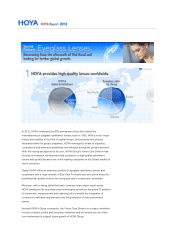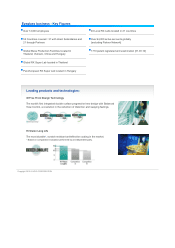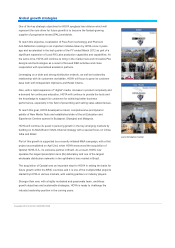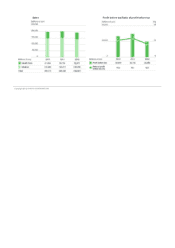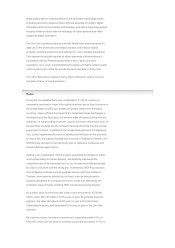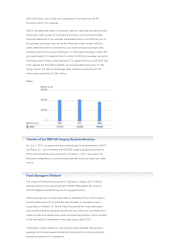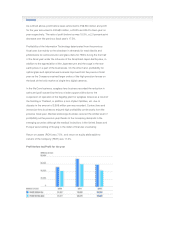Pentax 2012 Annual Report Download - page 61
Download and view the complete annual report
Please find page 61 of the 2012 Pentax annual report below. You can navigate through the pages in the report by either clicking on the pages listed below, or by using the keyword search tool below to find specific information within the annual report.
Co
py
ri
g
ht 2012 © HOYA CORPORATION
Nd-Vd Diagram [Enlarge]
Pressing of Optical Glass
The optical properties of optical glass are expressed numerically by a refractive
index and Abbe number (reciprocal dispersion). Even with glass that appears the
same at first glance, different refractive indexes and Abbe numbers produce
entirely different characteristics. Mapping out these two properties produces a
diagram that looks a lot like the Japanese archipelago (diagram at right).
Glass HOYA produces can be roughly divided into three categories, lenses that
correct chromatic aberration (FCD family; “A” area on diagram), lenses with a
high refractive index (FDS family; “B” area on the diagram), and lenses that
combine both properties (TAFD family; “C” area on the diagram). There are
around 100 types. The lens module used in a standard camera is made by
combining multiple lenses with these differing properties.
These optical glass lenses are manufactured by mixing a material called silica
sand with several types of rare earth as necessary and then melting the mixture in
a melting furnace and later pressing it into lens products.
In addition, HOYA provides other lens manufacturers with optical glass materials
that have yet to be processed into lenses. It also offers spherical lenses
manufactured using the lens processing and polishing processes, as well as
aspherical molded lenses produced by aspherical lens pressing after
transforming glass material into preform.
In this way, HOYA is a reliable supplier of several thousand optical glass pressed
products and lenses every month.



